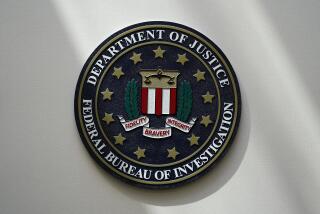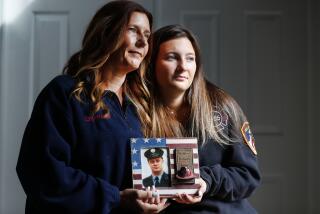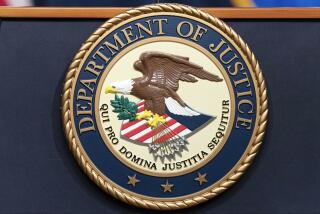New Plot Details Emerge
Khalid Shaikh Mohammed, the man who conceived and directed the Sept. 11 terrorist attacks, was motivated by his strong disagreement with American support for Israel, according to the final report of the Sept. 11 commission.
Mohammed conceived the initial outline of the attack six years before its execution and brought the plan to Al Qaeda leader Osama bin Laden because he thought he did not have the resources to carry it out on his own.
The Sept. 11 report, released Thursday, largely reaffirms what has been known about the basic overview of the attacks -- much of it first revealed by the commission’s interim reports -- and contains no revelations about the plot to attack the World Trade Center and government buildings in and around Washington. But it adds fresh details about the people who conceived and executed it.
The report contains the fullest accounting of Mohammed’s overarching role from original conception to supervision of details. Bin Laden, too, was fully involved, selecting all or most of the participants, ordering the substance and the location of their training, and contributing to the timing of the attacks and the selection of targets, the report says.
The report makes a strong case that Al Qaeda accomplished the attacks without any hint of state sponsorship.
The report also appears to lay to rest the notion -- long alluded to by administration officials, including Vice President Dick Cheney -- that hijacker Mohamed Atta traveled to the Czech Republic to meet an Iraqi intelligence operative in the spring of 2001. In addition to repeating evidence that Atta was in the United States at the time, the report reveals that the Iraqi agent also was not in Prague when the meeting was alleged to have occurred.
Much of the report’s detail comes from interrogations of Al Qaeda operatives in U.S. custody, including Mohammed and Ramzi Binalshibh. Some of that information is contradictory; much of it is difficult to corroborate. One CIA analysis cited in the report, for example, is titled “Khalid Shaykh Muhammed’s Threat Reporting -- Precious Truths, Surrounded by a Bodyguard of Lies.”
The report -- in particular, its depiction of Mohammed’s role -- argues against the view that Al Qaeda was a huge, sophisticated organization with boundless resources and skills.
The report instead depicts it as a relatively small core of men, headed by Bin Laden, at the center of a large web of sometimes competing and sometimes cooperative smaller organizations and individuals throughout the world. This reinforces an early view of Al Qaeda by a former State Department analyst, Stephen P. Cohen, who characterized it as the Ford Foundation of terrorism -- an organization that, at least in its formative period, sat back and listened to proposals for terrorist attacks from individuals and organizations.
One organization with which Al Qaeda came to work closely was Jemaah Islamiah, a terrorist group in Southeast Asia. Al Qaeda provided funding and training for the group and in return was given access to its membership and logistical bases. Among the results of that cooperation was an unsuccessful research program into the development of anthrax weapons conducted by Bin Laden’s second in command, Ayman Zawahiri, and an American-educated Jemaah Islamiah chemical engineer.
Initially, Mohammed was among those freelance petitioners.
Mohammed was born in Kuwait to parents who had emigrated from Baluchistan, a sprawling, rugged region that lies across the intersection of Pakistan, Iran and Afghanistan. He came to the United States for college, earning an engineering degree from North Carolina Agricultural and Technical State University in 1986. After he was captured in Pakistan in early 2003, he told his interrogators that although he had developed no special complaint about America in his years here, he felt strongly that U.S. support of Israel was wrong and could be corrected by attacking the United States.
Soon after graduating, Mohammed joined the Afghan fight against the Soviet Union, working first with Afghan warlord Abdul Rasul Sayyaf and then with Abdullah Azzam, a Palestinian intellectual who was Bin Laden’s mentor. Mohammed first met Bin Laden during the Afghan war but did not have a special relationship with him, the report says.
After the war, Mohammed was inspired by the first attack on the World Trade Center, in 1993. That mission was led by Mohammed’s nephew, Ramzi Ahmed Yousef, with whom Mohammed later allied in a plan to blow up as many as a dozen American airliners over the Pacific Ocean.
The failure of that plan led Mohammed, who had been working as a mechanical engineer in a government ministry of the Persian Gulf nation of Qatar, to take refuge in Afghanistan in 1996. It was then that he sought to interest Bin Laden in an operation to attack the United States from the air.
In his interrogations, Mohammed styled himself as a sort of freelance entrepreneur of terrorism, seeking venture capital to fund his plans. In an early version of the Sept. 11 plot, he proposed flying one of the hijacked planes himself, landing it in the United States and, after killing all the men aboard, making a speech urging America to change its Middle East policies. Bin Laden eliminated that flourish from the attack plan.
Even after Bin Laden approved funding for Mohammed’s plot in late 1998 or early 1999, Mohammed resisted invitations to swear loyalty to Bin Laden and formally join Al Qaeda. He resisted, in part, he told interrogators, because he had a prior allegiance to Sayyaf, the Afghan warlord, who was in turn allied with the Northern Alliance, led by Ahmed Shah Massoud.
Bin Laden was allied with the ruling Taliban, which was at war with Massoud’s group. To aid the Taliban in that war, Al Qaeda plotted the assassination of Massoud, which occurred two days before Sept. 11. Mohammed eventually joined Al Qaeda, he told interrogators.
The report offers little new on the men who led the hijackings in the United States -- pilots Atta, Ziad Samir Jarrah, Marwan Al-Shehhi and Hani Hanjour -- but provides information on the 15 other hijackers, who supplied the muscle to take control of the planes.
All but one of those supporting hijackers were from Saudi Arabia and were chosen from among volunteers at Al Qaeda’s Afghan terrorist camps. When they left Saudi Arabia, almost all told their families or friends they were going to fight in the Russian separatist republic of Chechnya, but many were diverted to Afghanistan because they were warned that routes to Chechnya were more difficult to traverse.
Men who attended the Al Qaeda camps in Afghanistan, who numbered in the thousands, were required to fill out questionnaires on their personal histories, skills and willingness to take part in suicide operations, according to the report. Once the plotting was underway in 1999, Al Qaeda operatives checked these questionnaires for potential volunteers. Those chosen were singled out for special attention in the camps, often including meetings with Bin Laden.
Mohammed told his interrogators that Bin Laden chose the supporting hijackers in these meetings, sometimes making a decision on a potential hijacker in as little as 10 minutes. Bin Laden’s seeming seat-of-the-pants decision-making was in keeping with his organization’s lack of sophistication, the report says.
The report also describes how Mohammed trained recruits on how to operate in the United States by teaching them basic English phrases and showing them how to use the Yellow Pages. He also screened Hollywood movies that featured aircraft hijackings and bought flight-simulation software games for them to practice on.
*
(BEGIN TEXT OF INFOBOX)
Attack timeline
Events leading to the Sept. 11 attacks, as described by the National Commission on Terrorist Attacks Upon the United States:
Mid-1996: Khalid Shaikh Mohammed meets with Osama bin Laden in Afghanistan. He presents several ideas for attacks against the U.S. Bin Laden does not commit.
1998: Mohamed Atta and Marwan Al-Shehhi share an apartment with Ramzi Binalshibh in Hamburg, Germany.
Early 1999: Bin Laden summons Khalid Shaikh Mohammed to Kandahar, Afghanistan, to discuss using aircraft as weapons. They develop a list of targets including the White House, the Pentagon, the Capitol and the World Trade Center. Bin Laden provides Mohammed with four suicide operatives, including Khalid Almihdhar and Nawaf Alhazmi.
Late 1999: Most of the future “muscle hijackers” -- those responsible for taking on passengers -- begin pursuing jihad, making way to camps in Afghanistan. Most return to Saudi Arabia to obtain visas, then return to Afghanistan for training.
November-December 1999: Atta, Ziad Samir Jarrah, Al-Shehhi and Binalshibh travel separately to Afghanistan. Bin Laden’s deputy, Mohammed Atef, later directs Atta, Jarrah and Binalshibh to enroll in flight training in Germany. Atta is chosen mission leader.
2000: Hani Hanjour arrives at an Al Qaeda camp in Afghanistan, is identified as a pilot, and is sent to Mohammed to be included in plot.
Jan. 15, 2000: Almihdhar and Alhazmi enter the United States.
Feb. 5: Alhazmi and Almihdhar move to San Diego to learn English and take flying lessons.
March: Al-Shehhi, Atta, Jarrah and Binalshibh begin researching flight schools in Germany, but find that training in the United States would be cheaper and faster. Atta, Al-Shehhi and Jarrah obtain U.S. visas, but Binalshibh is rejected.
May: Al-Shehhi, Jarrah and Atta begin arriving in U.S. They enroll in flight schools in Venice, Fla.
Sept. 25: Hanjour obtains a U.S. student visa, then travels to the United Arab Emirates for funds.
Late 2000: Atta, Jarrah, and Al-Shehhi begin training on jet aircraft simulators.
Early 2001: Atta, Jarrah and Al-Shehhi leave the U.S. on various foreign trips. Atta meets with Binalshibh in Germany. Binalshibh then heads to Afghanistan to brief Al Qaeda leadership. Al-Shehhi takes a trip to Casablanca, Morocco.
April: “Muscle hijackers” start arriving in the United States.
May 24: Al-Shehhi, Jarrah and Atta begin taking cross-country surveillance flights and additional flight training.
July 4: Almihdhar re-enters the United States, joins Hanjour and Alhazmi in Paterson, N.J.
Mid-July: Atta meets with Binalshibh in Spain. Atta reports they have been able to carry box cutters onto test flights.
Aug 26: Conspirators begin purchasing flight tickets.
Sept. 7: Atta flies from Fort Lauderdale, Fla., to Baltimore, presumably to meet with hijack team staying in Laurel, Md.
Sept. 9: Atta flies from Baltimore to Boston, where Al-Shehhi and his hijack team are stationed.
Sept. 11: Two hijacked planes crash into the World Trade Center, one hits the Pentagon and another crashes into a Pennsylvania field.
Source: Associated Press
More to Read
Sign up for Essential California
The most important California stories and recommendations in your inbox every morning.
You may occasionally receive promotional content from the Los Angeles Times.










